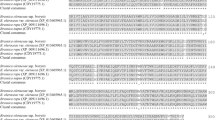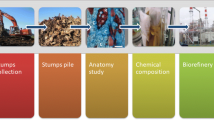Abstract
Using a combination of cDNA cloning and protein purification it is demonstrated that bark of yellow wood (Cladrastis lutea) contains two mannose/glucose binding lectins and a lectin-related protein which is devoid of agglutination activity. One of the lectins (CLAI) is the most prominent bark protein. It is built up of four 32 kDa monomers which are post-translationally cleaved into a 15 kDa and a 17 kDa polypeptide. The second lectin (CLAII) is a minor protein, which strongly resembles CLAI except that its monomers are not cleaved into smaller polypeptides. Molecular cloning of the Cladrastis lectin family revealed also the occurrence of a lectin-related protein (CLLRP) which is the second most prominent bark protein. Although CLLRP shows sequence homology to the true lectins, it is devoid of carbohydrate binding activity. Molecular modelling of the three Cladrastis proteins has shown that their three-dimensional structure is strongly related to the three-dimensional models of other legume lectins and, in addition, revealed that the presumed carbohydrate binding site of CLLRP is disrupted by an insertion of three extra amino acids. Since it is demonstrated for the first time that a lectin and a noncarbohydrate binding lectin-related protein are the two most prominent proteins in the bark of a tree, the biological meaning of their simultaneous occurrence is discussed.
Similar content being viewed by others
References
Baba K, Ogawa M, Nagano A, Kuroda H, Sumiya K: Developmental changes in the bark lectin of Sophora japonica L. Planta 183: 462–470 (1991).
Bourne Y, Abergel C, Cambillau C, Frey M, Rougé P, Fontecilla-Camps JC: X-ray crystal structure determination and refinement at 1.9Å resolution of isolectin I from the seeds of Lathyrus ochrus. J Mol Biol 214: 571–584 (1990).
Bourne Y, Roussel A, Frey M, Rougé P, Fontecilla-Camps JC, Cambillau C: Three-dimensional structures of complexes of Lathyrus ochrus isolectin I with glucose and mannose: fine specificity of the monosaccharide binding site. Proteins 8: 365–376 (1990).
Broekaert WF, Nsimba-Lubaki M, Peeters B, Peumans WJ: A lectin from elderberry (Sambucus nigra) bark. Biochem J 221: 163–169 (1984).
Carrington DM, Auffret A, Hanke DE: Polypeptide ligation occurs during post-translational modification of concanavalin A. Nature 313: 64–67 (1985).
Chawla D, Animashaun T, Hughes RC, Harris A, Aitken A: Bowringia mildbraedii agglutinin: polypeptide composition, primary structure and homologies with other legume lectins. Biochim Biophys Acta 1202: 38–46 (1993).
de Kochko A, Hamon S: A rapid and efficient method for the isolation of restrictable total DNA from plants of the genus Abelmoschus. Plant Mol Biol Rep 8: 3–7 (1990).
Dellaporta SL, Wood J, Hicks JB: A plant DNA minipreparation: version II. Plant Mol Biol Rep 1: 19–21 (1983).
Derewenda Z, Yariv J, Helliwell JR, Kalb (Gilboa)AJ, Dodson EJ, Paiz MZ, Wang T, Campbell J: The structure of the saccharide-binding site of concanavalin A. EMBO J 8: 2189–2193 (1989).
Dubois M, Gilles KA, Hamilton JK, Rebers PA, Smith F: Colorimetric method for determination of sugar and related substances. Anal Chem 28: 350–356 (1956).
Einspahr H, Parks EH, Suguna K, Subramanian E, Syddath FL: The crystal structure of pea lectin at 3.0-Å resolution. J Biol Chem 261: 16518–16527 (1986).
Gaboriaud C, Bissery V, Benchetrit T, Mornon JP: Hydrophobic cluster analysis: an efficient new way to compare and analyse amino acid sequences. FEBS Lett 224: 149–155 (1987).
Goldstein IJ, Poretz RD: Isolation, physicochemical characterization and carbohydrate binding specificity of lectins. In: Liener IE, Sharon N, Goldstein IJ (eds) The Lectins: Properties, Functions and Applications in Biology and Medicine, pp. 33–248, Academic Press, New York (1986).
Gowda LR, Savaithri HS, Rao DR: The complete primary structure of a unique mannose/glucose-specific lectin from field bean (Dolichos lab lab). J Biol Chem 269: 18789–18793 (1994).
Greenwood J, Stinissen H, Peumans WJ, Chrispeels MJ: Sambucus nigra agglutinin is located in protein bodies in the phloem parenchyma of bark. Planta 167: 275–278 (1986).
Higgins TJV, Chandler PM, Zurawski G, Button SC, Spencer D: The biosynthesis and primary structure of pea seed lectin. J Biol Chem 258: 9544–9549 (1983).
Hopp TP, Woods KR: Prediction of protein antigenic determinants from amino acid sequences. Proc Natl Acad Sci USA 78: 3824–3828 (1981).
Knibbs R, Goldstein IJ, Ratcliff RM, Shibuya N: Characterization of the carbohydrate binding specificity of the Leukoagglutinating lectin from Maackia amurensis. Comparison with other sialic acid-specific lectins. J Biol Chem 266: 83–88 (1991).
Konami Y, Ishida C, Yamamoto K, Osawa T, Irimura T: A unique amino acid sequence involved in the putative carbohydrate-binding domain of a legume lectin specific for sialylated carbohydrate chains: primary sequence determination of Maackia amurensis hemagglutinin (MAH). J Biochem 115: 767–777 (1994).
Kyte J, Doolittle RF: A simple method for displaying the hydropathic character of a protein. J Mol Biol 157: 105–132 (1982).
Laemmli UK: Cleavage of structural proteins during the assembly of the head of bacteriophage T4. Nature 227: 680–685 (1970).
Lemesle-Varloot L, Henrissat B, Gaboriaud C, Bissery V, Morgat A, Mornon JP: Hydrophobic cluster analysis: procedure to derive structural and functional information from 2-D-representation of protein sequences. Biochimie 72: 555–574 (1990).
Le Moal MA, Colle JH, Galelli A, Truffa-Bachi P: Mouse lymphocyte-T activation by Urtica dioica agglutinin. 1. Delineation of 2 lymphocyte subsets. Res Immunol 143: 691–700 (1992).
Maniatis T, Fritsch EF, Sambrook J: Molecular Cloning: A Laboratory Manual. Cold Spring Harbor Laboratory, Cold Spring Harbor, NY (1982).
Mierendorf RC, Pfeffer D: Direct sequencing of denatured plasmid DNA. Meth Enzymol 152: 556–562 (1987).
Mirkov E, Wahlstrom JM, Hagiwara K, Finardi-Filho F, Kjemtrup S, Chrispeels MJ: Evolutionary relationships among proteins in the phytohemagglutinin-arcelin-α-amylase inhibitor family of the common bean and its relatives. Plant Mol Biol 26: 1103–1113 (1994).
Motta I, Colle JH, Shidani B, Truffa-Bachi P: Interleukin-2/Interleukin-4-independent T helper cell generation during an in vitro antigenic stimulation of mouse spleen cells in the presence of cyclosporin A. Eur J Immunol 21: 551–557 (1991).
Nsimba-Lubaki M, Peumans WJ: Seasonal fluctuations of lectins in barks of elderberry (Sambucus nigra) and black locust (Robinia pseudoacacia). Plant Physiol 80: 747–751 (1986).
Parker JMR, Guo D, Hodges RS: New hydrophilicity scale derived from high-performance liquid chromatography peptide retention data: correlation of predicted surface residues with antigenicity and X-ray-derived accessible sites. Biochemistry 25: 5425–5432 (1986).
Peumans WJ, Van Damme EJM: The role of lectins in the defense of plants. In: E Van Driessche, H Franz, S Beeckmans, U Pfuller, A Kallikorm, TC Bog-Hansen (eds) Lectins: Biology-Biochemistry, Clinical Biochemistry, Vol. 8, pp. 82–91 Textop, Hellerup, Denmark (1993).
Peumans WJ, Van Damme EJM: The role of lectins in plant defence. Histochem J. 27: 253–271 (1995).
Richardson M, Rouge P, Sousa-Cavada B, Yarwood A: The amino acid sequences of the α1 and α2 subunits of the isolectins from seeds of Lathyrus ochrus (L.) DC. FEBS Lett 175: 76–81 (1984).
Rini JM, Hardman KD, Einspathr H, Suddath FL, Carver JP: X-ray crystal structure of a pea lectin-trimannoside complex at 2.6A resolution. J Biol Chem 268: 10126–10132 (1993).
Rougé P, Cambillau C, Bourne Y: The three-dimensional structure of legume lectins. In: DC Kilpatrick, E Van Driessche, TC Bog-Hansen (eds) Lectin Reviews, vol. 1, pp. 143–159, Sigma Chemical Co., St Louis, MO (1991).
Sanger F, Nicklen S, Coulson AR: DNA sequencing with chain terminating inhibitors. Proc Natl Acad Sci USA 74: 5463–5467 (1977).
Ueno M, Ogawa H, Matsumoto I, Seno N: A novel mannose-specific and sugar specifically aggregatable lectin from the bark of the Japanese pagoda tree (Sophora japonica). J Biol Chem 266: 3146–3153 (1991).
Van Damme EJM, Smeets K, Torrekens S, Van Leuven L, Goldstein IJ, Peumans WJ: The closely related homomeric and heterodimeric mannose-binding lectins from garlic are encoded by one-domain and two-domain lectin genes, respectively. Eur J Biochem 206: 413–420 (1992).
Van Damme EJM, Goldstein IJ, Vercammen G, Vuylsteke J, Peumans WJ: Lectins of members of the Amaryllidaceae are encoded by multigene families which show extensive homology. Physiol Plant 86: 245–252 (1992).
Van Damme EJM, Peumans WJ: Cell-free synthesis of lectins. In: Gabius H-J, Gabius S (eds) Lectins and Glycobiology. pp. 458–468, Springer Verlag, Berlin/heidelberg/New York (1993).
Van Damme EJM, Barre A, Smeets K, Torrekens S, Van Leuven F, Rougé P, Peumans WJ: The bark of Robinia pseudoacacia contains a complex mixture of lectins. Plant Physiol 107: 833–843 (1995).
von Heijne G: A method for predicting signal sequence cleavage sites. Nucl Acids Res 11: 4683–4690 (1986).
Wetzel S, Demmers C, Greenwood JS: Seasonally fluctuating bark proteins are a potential form of nitrogen storage in three temperate hardwoods. Planta 178: 275–281 (1989).
Yamamoto K, Ishida C, Saito M, Konami Y, Osawa T, Irimura T: Cloning and sequence analysis of the Maackia amurensis haemagglutinin cDNA. Glycoconjugate J 11: 572–575 (1994).
Yarwood A, Richardson M, Sousa-Cavada B, Rougé P: The complete amino acid sequences of the β1 and β2 subunits of the isolectins LoLI and LoLII from seeds of Lathyrus ochrus (L.) DC. FEBS Lett 184: 104–109 (1985).
Yoshida K, Baba K, Yamamoto N, Tazaki K: Cloning of a lectin cDNA and seasonal changes in levels of the lectin and its mRNA in the inner bark of Robinia pseudoacacia. Plant Mol Biol 25: 845–853 (1994).
Author information
Authors and Affiliations
Rights and permissions
About this article
Cite this article
Van Damme, E.J.M., Barre, A., Bemer, V. et al. A lectin and a lectin-related protein are the two most prominent proteins in the bark of yellow wood (Cladrastis lutea).. Plant Mol Biol 29, 579–598 (1995). https://doi.org/10.1007/BF00020986
Issue Date:
DOI: https://doi.org/10.1007/BF00020986




